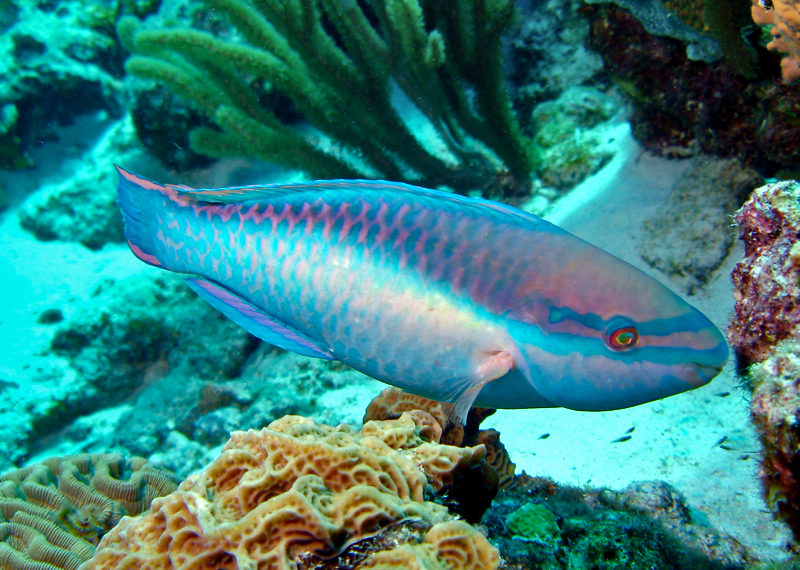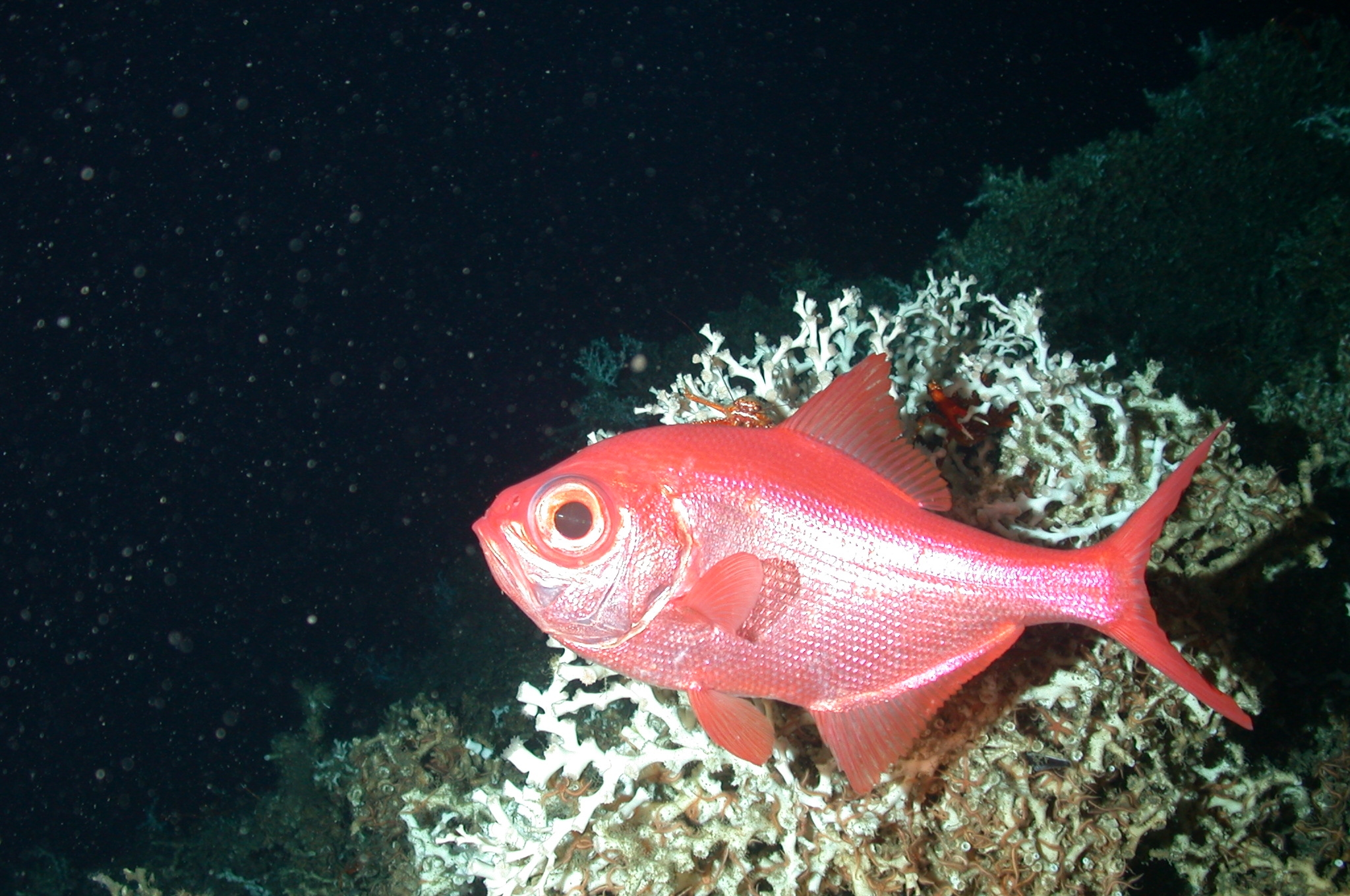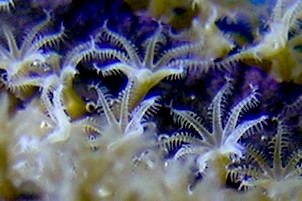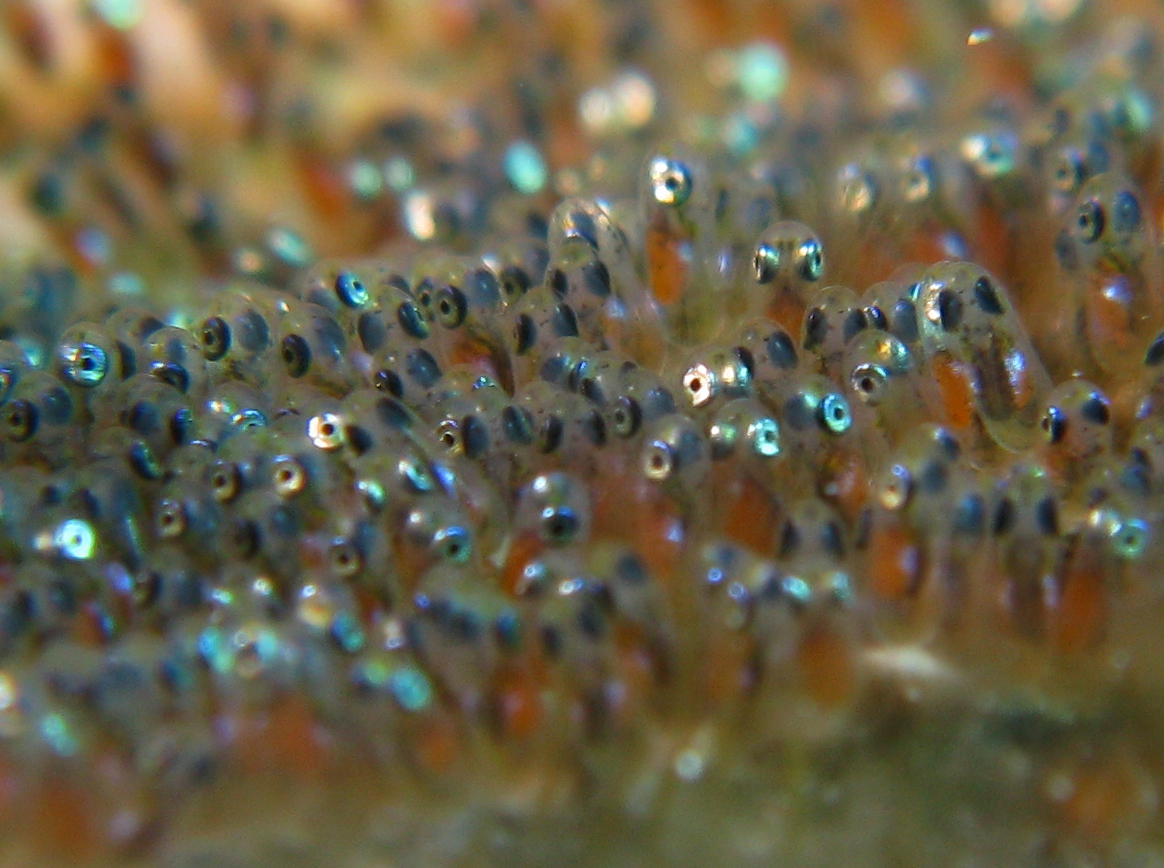|
Coral
Corals are colonial marine invertebrates within the subphylum Anthozoa of the phylum Cnidaria. They typically form compact Colony (biology), colonies of many identical individual polyp (zoology), polyps. Coral species include the important Coral reef, reef builders that inhabit tropical oceans and secrete calcium carbonate to form a hard skeleton. A coral "group" is a colony of very many cloning, genetically identical polyps. Each polyp is a sac-like animal typically only a few millimeters in diameter and a few centimeters in height. A set of tentacles surround a central mouth opening. Each polyp excretes an exoskeleton near the base. Over many generations, the colony thus creates a skeleton characteristic of the species which can measure up to several meters in size. Individual colonies grow by asexual reproduction of polyps. Corals also breed sexually by spawning: polyps of the same species release gametes simultaneously overnight, often around a full moon. Fertilized eggs form ... [...More Info...] [...Related Items...] OR: [Wikipedia] [Google] [Baidu] |
Coral Reef
A coral reef is an underwater ecosystem characterized by reef-building corals. Reefs are formed of colonies of coral polyps held together by calcium carbonate. Most coral reefs are built from stony corals, whose polyps cluster in groups. Coral belongs to the class Anthozoa in the animal phylum Cnidaria, which includes sea anemones and jellyfish. Unlike sea anemones, corals secrete hard carbonate exoskeletons that support and protect the coral. Most reefs grow best in warm, shallow, clear, sunny and agitated water. Coral reefs first appeared 485 million years ago, at the dawn of the Early Ordovician, displacing the microbial and sponge reefs of the Cambrian. Sometimes called ''rainforests of the sea'', shallow coral reefs form some of Earth's most diverse ecosystems. They occupy less than 0.1% of the world's ocean area, about half the area of France, yet they provide a home for at least 25% of all marine species, including fish, mollusks, worms, crustaceans, ... [...More Info...] [...Related Items...] OR: [Wikipedia] [Google] [Baidu] |
Antipatharia
Antipatharians, also known as black corals or thorn corals, are an order of soft deep-water corals. These corals can be recognized by their jet-black or dark brown chitin skeletons, which are surrounded by their colored polyps (part of coral that is alive). Antipatharians are a cosmopolitan order, existing in nearly every oceanic location and depth, with the sole exception of brackish waters. However, they are most frequently found on continental slopes under deep. A black coral reproduces both sexually and asexually throughout its lifetime. Many black corals provide housing, shelter, food, and protection for other animals. Black corals were originally classified in the order Ceriantipatharia along with ceriantharians (tube-dwelling anemones), but were later reclassified under Hexacorallia. Though they have historically been used by Pacific Islanders for medical treatment and in rituals, its only modern use is making jewelry. Black corals have been declining in numbers and ... [...More Info...] [...Related Items...] OR: [Wikipedia] [Google] [Baidu] |
Scleractinia
Scleractinia, also called stony corals or hard corals, are marine animals in the phylum Cnidaria that build themselves a hard skeleton. The individual animals are known as polyps and have a cylindrical body crowned by an oral disc in which a mouth is fringed with tentacles. Although some species are solitary, most are colonial. The founding polyp settles and starts to secrete calcium carbonate to protect its soft body. Solitary corals can be as much as across but in colonial species the polyps are usually only a few millimetres in diameter. These polyps reproduce asexually by budding, but remain attached to each other, forming a multi-polyp colony of clones with a common skeleton, which may be up to several metres in diameter or height according to species. The shape and appearance of each coral colony depends not only on the species, but also on its location, depth, the amount of water movement and other factors. Many shallow-water corals contain symbiont unicellular organis ... [...More Info...] [...Related Items...] OR: [Wikipedia] [Google] [Baidu] |
Anthozoa
Anthozoa is one of the three subphyla of Cnidaria, along with Medusozoa and Endocnidozoa. It includes Sessility (motility), sessile marine invertebrates and invertebrates of brackish water, such as sea anemones, Scleractinia, stony corals, soft corals and sea pens. Almost all adult anthozoans are attached to the seabed, while their larvae can disperse as plankton. The basic unit of the adult is the polyp (zoology), polyp, an individual animal consisting of a cylindrical column topped by a disc with a central mouth surrounded by tentacles. Sea anemones are mostly solitary, but the majority of corals are colony (biology), colonial, being formed by the budding of new polyps from an original, founding individual. Colonies of stony corals are strengthened by mainly aragonite and other materials, and can take various massive, plate-like, bushy or leafy forms. Members of Anthozoa possess cnidocytes, a feature shared among other cnidarians such as the jellyfish, box jellyfish, box jellies ... [...More Info...] [...Related Items...] OR: [Wikipedia] [Google] [Baidu] |
Great Barrier Reef
The Great Barrier Reef is the world's largest coral reef system, composed of over 2,900 individual reefs and 900 islands stretching for over over an area of approximately . The reef is located in the Coral Sea, off the coast of Queensland, Australia, separated from the coast by a channel wide in places and over deep. The Great Barrier Reef can be seen from outer space and is the world's biggest single structure made by living organisms. This reef structure is composed of and built by billions of tiny organisms, known as coral polyp (zoology), polyps. It supports a wide diversity of life and was selected as a World Heritage Site in 1981. CNN labelled it one of the Seven Wonders of the World#Seven Natural Wonders of the World, Seven Natural Wonders of the World in 1997. Australian World Heritage places included it in its list in 2007. The Queensland National Trust named it a state icon of Queensland in 2006. A large part of the reef is protected by the Great Barrier Reef Mar ... [...More Info...] [...Related Items...] OR: [Wikipedia] [Google] [Baidu] |
Cnidaria
Cnidaria ( ) is a phylum under kingdom Animalia containing over 11,000 species of aquatic invertebrates found both in fresh water, freshwater and marine environments (predominantly the latter), including jellyfish, hydroid (zoology), hydroids, sea anemones, corals and some of the smallest marine parasites. Their distinguishing features are an uncentralized nervous system distributed throughout a gelatinous body and the presence of cnidocytes or cnidoblasts, specialized cells with ejectable flagella used mainly for envenomation and capturing prey. Their bodies consist of mesoglea, a non-living, jelly-like substance, sandwiched between two layers of epithelium that are mostly one cell (biology), cell thick. Cnidarians are also some of the few animals that can reproduce both sexually and asexually. Cnidarians mostly have two basic body forms: swimming medusa (biology), medusae and sessility (motility), sessile polyp (zoology), polyps, both of which are radially symmetrical with mou ... [...More Info...] [...Related Items...] OR: [Wikipedia] [Google] [Baidu] |
Alcyonacea
Alcyonacea is the old scientific order name for the informal group known as "soft corals". It is now an unaccepted name for class Octocorallia. It became deprecated . The following text should be considered a historical, outdated way of treating the taxonomy of Anthozoa and Octocorallia. Some, or many parts of it, are no longer valid. Any remaining information found to be still valid, should be carefully merged into Octocorallia. Alcyonacea are an order of sessile colonial cnidarians that are found throughout the oceans of the world, especially in the deep sea, polar waters, tropics and subtropics. Whilst not in a strict taxonomic sense, Alcyonacea are commonly known as soft corals. The term "soft coral" generally applies to organisms in the two orders Pennatulacea and Alcyonacea with their polyps embedded within a fleshy mass of coenenchymal tissue. Consequently, the term "gorgonian coral" is commonly handed to multiple species in the order Alcyonacea that produce a min ... [...More Info...] [...Related Items...] OR: [Wikipedia] [Google] [Baidu] |
Octocorallia
Octocorallia, along with Hexacorallia, is one of the two extant classes of Anthozoa. It comprises over 3,000 species of marine and brackish animals consisting of colonial polyps with 8-fold symmetry, commonly referred informally as "soft corals". It was previously known by the now unaccepted scientific names Alcyonacea and Gorgonacea, both deprecated , and by the also deprecated name of Alcyonaria, in earlier times. Its only two orders are Malacalcyonacea and Scleralcyonacea, which include corals such as those under the common names of blue corals, sea pens, and gorgonians (sea fans and sea whips). These animals have an internal skeleton secreted by their mesoglea, and polyps with tipically eight tentacles and eight mesenteries. As is the case with all cnidarians, their complex life cycle includes a motile, planktonic phase (a larva called planula), and a later characteristic sessile phase. Octocorals have existed at least since the Ordovician period, as shown by Maurit ... [...More Info...] [...Related Items...] OR: [Wikipedia] [Google] [Baidu] |
Rugosa
The Rugosa or rugose corals are an extinct Class (biology), class of solitary and Colony (biology), colonial corals that were abundant in Middle Ordovician to Late Permian seas. Solitary rugosans (e.g., ''Caninia (genus), Caninia'', ''Lophophyllidium'', ''Neozaphrentis'', ''Streptelasma'') are often referred to as ''horn corals'' because of a unique horn-shaped chamber with a wrinkled, or wiktionary:rugose, rugose, wall. Some solitary rugosans reached nearly a meter (3 ft 3 in) in length. However, some species of rugose corals could form large colonies (e.g., ''Lithostrotion''). When radiating septa were present, they were usually in multiples of four, hence ''Tetracorallia'' in contrast to modern ''Hexacorallia'', colonial polyps generally with sixfold symmetry. Rugose corals have a skeleton made of calcite that is often fossilized. Like modern corals (Scleractinia), rugose corals were invariably benthic, living on the sea floor or in a reef-framework. Some symbiotic rugose ... [...More Info...] [...Related Items...] OR: [Wikipedia] [Google] [Baidu] |
Polyp (zoology)
A polyp in zoology is one of two forms found in the phylum Cnidaria, the other being the medusa (biology), medusa. Polyps are roughly cylindrical in shape and elongated at the axis of the vase-shaped body. In solitary polyps, the aboral (opposite to oral) end is attached to the substrate (biology), substrate by means of a disc-like holdfast (biology), holdfast called a pedal disc, while in colony (biology), colonies of polyps it is connected to other polyps, either directly or indirectly. The oral end contains the mouth, and is surrounded by a circlet of tentacles. Classes In the class Anthozoa, comprising the sea anemones and corals, the individual is always a polyp; in the class Hydrozoa, however, the individual may be either a polyp or a medusa (biology), medusa, with most species undergoing a biological life cycle, life cycle with both a polyp stage and a medusa stage. In the class Scyphozoa, the medusa stage is dominant, and the polyp stage may or may not be present, depen ... [...More Info...] [...Related Items...] OR: [Wikipedia] [Google] [Baidu] |
Spawning
Spawn is the Egg cell, eggs and Spermatozoa, sperm released or deposited into water by aquatic animals. As a verb, ''to spawn'' refers to the process of freely releasing eggs and sperm into a body of water (fresh or marine); the physical act is known as spawning. The vast majority of aquatic and amphibious animals reproduce through spawning. These include the following groups: *Bony fishes *Crustaceans (such as crabs, shrimps, etc.) *Mollusks (such as oysters, octopus, squid) *Echinoderms (such as sea urchins, sea stars, sea cucumbers, etc.) *Amphibians (such as frogs, toads, salamanders, newts) *Aquatic insects (such as dragonflies, mayflies, mosquitoes) *Coral, which are living colonies of tiny, aquatic organisms—not plants, as they are sometimes perceived to be. Corals, while appearing sedentary or botanical by nature, actually spawn by releasing clouds of sperm and egg cells into the water column, where the two mix. As a general rule, aquatic or semiaquatic reptiles, ... [...More Info...] [...Related Items...] OR: [Wikipedia] [Google] [Baidu] |
Hexacorallia
Hexacorallia is a Class (biology), class of Anthozoa comprising approximately 4,300 species of aquatic organisms formed of polyp (zoology), polyps, generally with 6-fold symmetry. It includes all of the stony corals, most of which are Colony (biology), colonial and reef-forming, as well as all sea anemones, and zoanthids, arranged within five extant Order (biology), orders. The hexacorallia are distinguished from another class of Anthozoa, Octocorallia, in having six or fewer axes of symmetry in their body structure; the tentacles are simple and unbranched and normally number more than eight. These organisms are formed of individual soft polyps which in some species live in colonies and can secrete a calcite skeleton. As with all Cnidarians, these organisms have a complex life cycle including a motile planktonic phase and a later characteristic Sessility (zoology), sessile phase. Hexacorallia also include the significant extinct order of rugose corals. Phylogeny Hexacorallia is ... [...More Info...] [...Related Items...] OR: [Wikipedia] [Google] [Baidu] |









